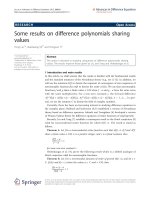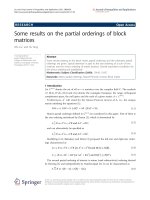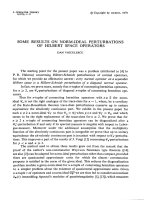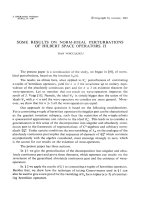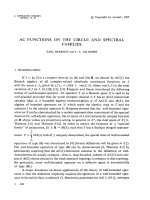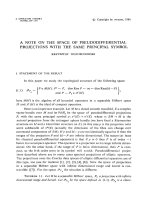Báo cáo toán học: "Some Results on the Relation Between Pluripolarity of Graphs and Holomorphicity" ppt
Bạn đang xem bản rút gọn của tài liệu. Xem và tải ngay bản đầy đủ của tài liệu tại đây (142.04 KB, 10 trang )
Vietnam Journal of Mathematics 34:3 (2006) 275–284
Some Results on the Relation Between
Pluripolarity of Graphs and Holomorphicity
Le Mau Hai and Phung Van Manh
Deparment of Mathematics, Hanoi University of Education
136 Xuan Thuy Rd., Hanoi, Vietnam
Received February 14, 2005
Revised April 13, 2006
Abstract. The aim of this paper is to give some results on the relation between
pluripolarity of graphs and holomorphicity of complex-valued functions. In particular,
we investigate the relation between the pluripolarity of graphs and the holomorphicity
of Hartogs type and of Forelli type.
2000 Mathematics Subject Classification: 32H02, 32H25, 32U05.
Keywords: Pluripolar sets, Holomorphic graphs of Hartogs type, holomorphic graphs
of Forelli type.
1. Introduction
In 2003 Shcherbina proved the following result which solves a problem posed
several years ago by Chirka (see [4]): Let D be a domain in C
n
and f : D → C
be a continuous function. The graph Γ(f )off is pluripolar subset of C
n+1
if
and only if f is holomorphic (see [10]). Next, Shcherbina extented the above
result to the multi-functions. Namely he proved that if a
1
(z), ··· ,a
m
(z) are
continuous on D such that the set:
E = {(z, w) ∈ D × C : w
m
+ a
1
(z)w
m−1
+ + a
m
(z)=0}
is a pluripolar set in C
n+1
then a
1
(z), ···,a
m
(z) are holomorphic on D (see
[11]). In this paper we give some results of type of Shcherbina on the relation
between pluriporlarity of graphs and holomorphicity of complex-valued functions
defined on a domain in C
n
. In particular we establish the relation between the
276 Le Mau Hai and Phung Van Manh
pluripolarity of graphs and the holomorphicity of Hartogs type and of Forelli
type (see Theorems 3.2 and 4.1 below). The paper is organized as follows.
Beside the introduction, the paper contains three sections. In the second one
we recall some well-known facts in the pluripotential theory. The third section
is devoted to present holomorphic graphs of Hartogs type. The fourth one deals
with holomorphic graphs of Forelli type.
2. Basic Definitions
In this section we recall some notions and fix some notations.
2.1. Let D be a domain in C
n
and ϕ : D → [−∞, +∞). ϕ is called plurisub-
harmonic on D if ϕ is upper semi-continuous and the restriction of ϕ to the
intersection of D with every complex line is subharmonic. The cone of plurisub-
harmonic functions on D is denoted by PSH(D).
A set E of C
n
is called plurip olar if for every a ∈ E there exitsts a neighbor-
hood U = U (a)ofa, ϕ ∈ PSH(U ), ϕ is not identity to −∞ such that ϕ = −∞
on U ∩ E. A basic theorem of Josefson (see [6], Theorem 4.7.4) asserts that if E
is pluripolar in a domain D in C
n
then there exists a plurisubharmonic function
ϕ on C
n
, ϕ is not identity to −∞ but E ⊂{z ∈ D : ϕ(z)=−∞}.
2.2. We recall the relatively extremal function due to Siciak (see [13]). Let D
be a domain in C
n
and A ⊂ D. The relatively extremal function h
A,D
of A to
D is defined by
h
A,D
= sup{u : u ∈ PSH(D),u≤ 1,u
A
≤ 0}.
By h
∗
A,D
we denote the upper semicontinuous regularization of h
A,D
. A set
A ⊂ D is called locally pluriregular if for any a ∈ A and any neighborhood
U = U (a)ofa we have h
∗
A∩U,U
(a)=0.
2.3. Let D ⊂ C
n
be a domain and f : D → C be a complex-valued function
defined on D. The graph of f is the set
Γ(f)={(z, f (z)) : z ∈ D}⊂D × C.
3. Holomorphic Graphs of Hartogs Type
The main aim of this section is to give a result above holomorphicity of a
complex-valued function under assumption that it is separately continuous and
its graph is pluripolar. As well-known that in the main result of Shcherbina
(see [10]), Shcherbina assume that if f : D → C is a continuous function and
the graph Γ(f)off is a pluripolar set in C
n+1
then f is holomorphic on D.
Now we prove a such result but under assumption weaker than the theorem of
Shcherbina. At the same time, this result itself is a form of Hartogs theorem.
However before proving this result we establish some results on the relation
between holomorphicity of a valued-complex function and pluripolarity of its
graph. Namely we prove the following result.
Some Results on the Relation Between 277
Theorem 3.1. Let p be a non-constant holomorphic function on C
m
\ S, where
S is a hypersurface in C
m
and f is a continuous function on a domain D ⊂ C
n
.
Assume that
Z = {(z, w) ∈ (C
m
\ S) × D : p(z)=f(w)}
is pluripolar in C
m
× D. Then f is holomorphic on D.
Proof. First we consider the case m =1.
Step 1. Given w
0
∈ D such that there exists z
0
∈ (C \ S) with p(z
0
)=f(w
0
).
Assume that p
(z
0
) = 0. Take two neighborhoods U ⊂ (C \ S) and V of z
0
and
υ
0
= p(z
0
) respectively such that p : U → V is biholomorphic. Consider the
biholomorphic map: θ : U ×f
−1
(V ) → V × f
−1
(V ) given by θ(z,w)=(p(z),w).
Then we have
θ(Z ∩ (U × f
−1
(V ))) = {(υ, w) ∈ C × f
−1
(V ):υ = f(w)}.
It follows that the graph of f |
f
−1
(V )
is plurip olar in f
−1
(V ) × C. By [10] f is
holomorphic on f
−1
(V ), a neighborhood of w
0
.
Step 2. Let z
0
∈ (C \ S), w
0
∈ D with p(z
0
)=f (w
0
), p
(z
0
) = 0. Since
p = const then we can choose a neighborhood U ⊂ (C \ S)ofz
0
such that
∀z ∈ U \z
0
,p
(z) =0andp(U )=V is a neighborhood of υ
0
= f(w
0
). By step 1
f is holomorphic on f
−1
(V \ υ
0
)=f
−1
(V ) \ f
−1
(υ
0
). Since f is continuous then
the Rado theorem implies that f is holomorphic on f
−1
(V ), a neighborhood of
w
0
.
Step 3. By Steps 1 and 2 the function f is holomorphic on a neighborhood of
f
−1
p(C \ S )
. Thus again by the Rado theorem without loss of generality we
may assume that C \ p(C \ S) is an infinite set. Hence p(C \ S) is hyperboli-
cally embedded into CT
1
. By the Kwack theorem (see [7]) p is extended to a
holomorphic map p : C → CT
1
. Since
{(z, w) ∈ (C \ p
−1
(∞)) × D : p(z)=f (w)}
is plurip olar, Steps 1 and 2 imply that f is holomorphic on a neighborhood of
f
−1
p(C \ p
−1
(∞)
. Since p = const, the little Picard theorem implies that
C \ p(C \ p
−1
(∞)) is finite. Again by the Rado theorem f is holomorphic on D.
Now assume that m>1. Since S is a hypersurface we can find a complex
line ⊂ C
m
such that ∩ S is discrete and p
∩(\S)
= const and the set
{(z, w) ∈ ( \ ∩ S) × D : p(z)=f(w)}
is pluripolar in × D. By the case m = 1 it follows that f is holomorphic on D.
As well-known that in complex analysis the Hartogs theorem says that if D
is a domain in C
n
and f : D → C is separately holomorphic on D then f is
holomorphic on D. Next we give a result of type of Hartogs theorem under the
278 Le Mau Hai and Phung Van Manh
hypothesis f is separately continuous and the graph Γ(f)off is pluripolar in
C
n+1
. Namely we prove the following result.
Theorem 3.2. Let D
j
⊂ C
k
j
be bounded pseudoconvex domains for j =
1, 2, ···,N and f : D = D
1
×···×D
N
→ C be a complex - valued function
defined on D. Assume that for every (a
1
, ···,a
N
) ∈ D
1
×···×D
N
the func-
tion f (a
1
, ···,a
j−1
,.,a
j+1
, ···,a
N
) is continuous on D
j
,j =1, 2, ···,N. If the
graph Γ(f ) of f :
Γ(f)={(z
1
, ···,z
N
,w) ∈ D × C : w = f(z
1
, ···,z
N
)}
is pluripolar in C
k
1
+···+k
N
+1
then f is holomorphic on D.
Proof. We prove Theorem 3.2 by induction. For N = 1 the result belongs to
Shcherbina [10]. We prove if for the case N = 2. Let D
1
⊂ C
n
,D
2
⊂ C
m
be
bounded pseudoconvex domains and f : D
1
× D
2
→ C be a complex-valued
function satisfying the followings:
(i) For every z
1
∈ D
1
the function f
z
1
(z
2
)=f(z
1
,z
2
) is continuous on D
2
.
(ii) For every z
2
∈ D
2
the function f
z
2
(z
1
)=f(z
1
,z
2
) is continuous on D
1
.
Assume that the graph Γ(f )off is pluripolar in C
n+m+1
. From the hypothesis
there exists u ∈ PSH(C
n+m+1
), u = −∞ such that
Γ(f) ⊂{(z
1
,z
2
,w) ∈ C
n+m+1
: u(z
1
,z
2
,w)=−∞}.
Assume that (z
1
,z
2
,w
) ∈ C
n+m+1
with u( z
1
,z
2
,w
) = −∞. Then the function
u
1
(z
1
,w)=u(z
1
,z
2
,w) and u
2
(z
2
,w)=u(z
1
,z
2
,w) are plurisubharmonic on
D
1
× C and D
2
× C respectively. Setting
E
1
= {z
1
∈ D
1
: u
1
(z
1
,w
)=−∞},
E
2
= {z
2
∈ D
2
: u
2
(z
2
,w
)=−∞}.
Then E
1
and E
2
are pluripolar sets in D
1
and D
2
respectively. Let A
1
= D
1
\E
1
and A
2
= D
2
\ E
2
. For each (z
0
1
,z
0
2
) ∈ A
1
× A
2
the function f
z
0
2
: D
1
→ C is
continuous and
Γ(f
z
0
2
)={(z
1
,w) ∈ D
1
× C : w = f
z
0
2
(z
1
)}
= {(z
1
,w) ∈ D
1
× C : w = f(z
1
,z
0
2
)}
⊂{(z
1
,w) ∈ D
1
× C : u(z
1
,z
0
2
,w)=−∞}
with u( z
1
,z
0
2
,w) > −∞, then Theorem 1 in [10] implies that f
z
2
is holomorphic
on D
1
. Similarly, the function f
z
0
1
: D
2
→ C is holomorphic on D
2
. Hence, f is
separately holomorphic on the cross X =(D
1
× A
2
) ∪ (A
1
× D
2
). We prove that
A
1
and A
2
are pluriregular in D
1
and D
2
respectively. Indeed, let a
1
∈ A
1
be
arbitrary. Take an arbitrary neighborhood U
1
of A
1
, U
1
⊂ D
1
. Consider the rela-
tively extremal function h
A
1
∩U
1
,U
1
= sup{u : u ∈ PSH(U
1
),u 1,u|
A
1
∩U
1
0}
and its upper - semicontinuous regularization h
∗
A
1
∩U
1
,U
1
. Then h
∗
A
1
∩U
1
,U
1
is
plurisubharmonic on U
1
. Put
F
1
= {z
1
∈ U
1
: h
A
1
∩U
1
,U
1
(z
1
) = h
∗
A
1
∩U
1
,U
1
(z
1
)}.
Some Results on the Relation Between 279
Theorem 7.1 in [3] implies that F
1
is pluripolar in U
1
and h
∗
A
1
∩U
1
,U
1
= h
A
1
∩U
1
,U
1
on U
1
\F
1
. Hence h
∗
A
1
∩U
1
,U
1
(z
1
) = 0 for z
1
∈ A
1
∩U
1
\F
1
. However, A
1
∩U
1
\F
1
=
U
1
\ E
1
∪ F
1
. It follows that h
∗
A
1
∩
U
1
,U
1
=0onU
1
and the desired conclusion
follows. Similarly, A
2
is pluriregular in D
2
. Theorem 2.2.4 in [1] implies that
f : X → C extends to a holomorphic function
f on
X = {(z
1
,z
2
) ∈ D
1
× D
2
:
h
∗
A
1
,D
1
(z
1
)+h
∗
A
2
,D
2
(z
2
) < 1}. Notice that from the above proof it follows that
h
∗
A
1
,D
1
=0onD
1
and h
∗
A
2
,D
2
=0onD
2
. Hence
X = D
1
× D
2
. For each
z
1
∈ D
1
we have that f
z
1
and
f
z
1
are continuous on D
2
and f
z
1
|
A
2
=
f
z
1
|
A
2
.On
the other hand, E
2
= D
2
\ A
2
is plurip olar. Hence f
z
1
=
f
z
1
on D
2
. Thus f =
f
on D
1
× D
2
and the proof for the case N = 2 is completed. Now we assume that
the conclusion of the theorem holds for N − 1 ≥ 2. Put k = k
1
+ ···+ k
N
. From
the hypothesis there exists u ∈ PSH(C
k+1
),u= −∞ such that
Γ(f) ⊂{(z
1
,z
2
, ···,w) ∈ C
k+1
: u(z
1
, ···,u
N
,w)=−∞}.
Take (z
1
,z
2
, ···,z
N
,w
) ∈ C
k+1
with u( z
1
,z
2
, ···,z
N
,w
) > −∞. Then the set
F
N
= {z
N
∈ D
N
: u(z
1
, ···,z
N−1
,z
N
,w
)=−∞}
is pluripolar in D
N
. For each z
0
N
∈ D
N
\F
N
the function u(z
1
, ···,z
N−1
,z
0
N
,w) ∈
PSH(C
k+1−k
N
). Notice that
{(z
1
, ···,z
N−1
,w) ∈ D
1
×···×D
N−1
× C : w = f(z
1
, ···,z
N−1
,z
0
N
)}
⊂{(z
1
, ···,z
N−1
,w) ∈ C
k+1−k
N
: u(z
1
, ···,z
N−1
,z
0
N
,w)=−∞}.
Hence, the inductive hypothesis implies that the function f(z
1
, ···,z
N−1
,z
0
N
)
is holomorphic on D
1
×···×D
N−1
. Since D
= D
1
×···×D
N−1
is bounded
pseudoconvex then the arguments in the above proof imply that there exist
pluripolar sets E
⊂ D
= D
1
×···×D
N−1
and E
N
⊂ D
N
,E
N
⊃ F
N
such that
f is separately holomorphic on the cross
X =(D × A
N
)
(A
× D
N
)
with A
= D
\ E
,A
N
= D
N
\ E
N
. The same arguments as in the above proof
complete the proof of Theorem 3.2.
4. Holomorphic Graphs of Forelli Type
In 1978 Forelli proved that if f : B
n
= B
n
(0, 1) → C is defined on the unit ball
B
n
(0, 1) in C
n
such that restrictions of f on every complex line l through 0 is
holomorphic and f is of C
∞
-class in a neighborhood of 0 then f is holomorphic on
B
n
(see [8]). In this section we establish a result of such typ e under assumption
that f is continuous on every complex line l through 0 and the graph Γ(f)is
pluripolar in C
n+1
. Namely we have the following.
Theorem 4.1. Let B
n
= B
n
(0, 1) be the unit ball in C
n
and f : B
n
→ C be
a function defined on B
n
. Suppose that f is continuous on every complex line
280 Le Mau Hai and Phung Van Manh
l through 0 ∈ C
n
and on a neighborhood of 0 ∈ B
n
. If the graph Γ(f) of f is
a pluripolar set in C
n+1
then there exists a family V of complex lines through
0 ∈ B
n
with λ
2n
(V )=0and a holomorphic function
˜
f on B
n
such that f =
˜
f
on B
n
\ V and a neighborhood of 0 ∈ B
n
.
To prove the theorem we need the following.
Lemma 4.2. Let E be a pluripolar set in B
n
\{0} and V =
z∈E
l
z
, where l
z
denotes the complex line through 0 and z. Then σ
1
(V ∩ ∂B
n
)=0and λ
2n
(V ∩
B
n
)=λ
2n
(V )=0, where σ
1
denotes the surface area measure on ∂B
n
and λ
2n
the Lebesgue measure in C
n
.
Proof. For each m ≥ 1weputE
m
= E \ B
n
1
m
and V
m
=
z∈E
1
m
l
z
, where
B
n
1
m
= {z ∈ B
n
: ||z|| <
1
m
}. Then V
m
⊂ V
m+1
and V =
∞
m=1
V
m
. Given
ε>0. By [2], the Hausdorff measure Λ
2
n−1
(E
m
) = 0 and, hence, there exists a
family of balls {B
n
(z
j
,r
j
)}
∞
j=1
such that r
j
<
1
2m
for all j ≥ 1,
∞
j=1
r
2n−1
j
<ε,
E
m
⊂
∞
j=1
B
n
(z
j
,r
j
). It follows that
∞
j=1
B
n
(z
j
,r
j
) ⊂{z ∈ C
n
:
1
2m
< ||z|| < 2}.
Let π
2
denote the projection from C
n
\{0} to ∂B
n
given by
π
2
(z)=2
z
||z||
.
Setting, for each j ≥ 1, S
j
= π
2
(B
n
(z
j
,r
j
)), then we have
V
m
∩ ∂B
n
2
⊂
∞
j=1
(π
2
(B
n
(z
j
,r
j
)).
Since B
n
(z
j
,r
j
) ⊂{z ∈ C
n
:
1
2m
< ||z|| < 2} it follows that there exists C =
C(m, n) such that:
σ
2
(S
j
) ≤ C.r
2n−1
j
∀j ≥ 1.
Hence
σ
2
(V
m
∩ ∂B
n
2
) ≤ (
∞
j=1
π
2
(B
n
(z
j
,r
j
)))
≤
∞
j=1
σ
2
(S
j
) ≤ C
∞
j=1
r
2n−1
j
≤ C.
Thus σ
2
(V
m
∩ ∂B
n
2
) = 0 and, hence,
σ
2
(V ∩ ∂B
n
2
) = lim
m→+∞
σ
2
(V
m
∩ ∂B
n
2
)=0.
Notice that σ
r
(V ∩ B
n
r
)=(
r
2
)
2n−1
σ
2
(V ∩ B
n
2
) then we infer that σ
r
(V ∩ ∂B
n
r
)=0
for all r>0. Consequently, σ
1
(V ∩ ∂B
n
)=0.
On the other hand
Some Results on the Relation Between 281
λ
2n
(V )=
R
2
n
χ
V
(ξ)dλ
2n
(ξ)=2n
+∞
0
dr
∂B
n
r
χ
V
(η)dσ
r
(η)=0
in which χ
V
denotes the characteristic function of V . The lemma is proved.
Now we are able to prove Theorem 4.1.
Proof of Theorem 4.1. From the hypothesis there exists u ∈ PSH(B
n
× C), u is
not identity to −∞ such that
Γ(f) ⊂{(z, w) ∈ B
n
× C : u(z,w)=−∞}
Assume that (z
,w
) ∈ B
n
× C with u( z
,w
) = −∞. Then v(z)=u(z, w
) ∈
PSH(B
n
). Set F = {z ∈ B
n
: v(z)=−∞} and E = F \{0}. Then E is a
pluripolar set in B
n
\{0}. Assume that z
0
∈ B
n
\ (E ∪{0}) is arbitrary. Then
f |
z
0
∩B
n
is continuous and Γ(f) |
l
z
0
∩B
n
is a plurip olar set. By [10] f |
z
0
∩B
n
is
holomorphic. On the other hand, if we put V =
z∈E
l
z
then Lemma 4.2 implies
that λ
2n
(V ) = 0. From the above proof it follows that f |
∩B
n
is holomorphic for
every complex line ⊂ (B
n
\ V ) through 0 ∈ B
n
. Moreover, from the hypothesis
there exists 0 <r<1 such that f is continuous on B
n
(0,r). Again by [10] f is
holomorphic on B
n
(0,r). Hence f is of C
∞
-class on B
n
(0,r). By shringking r
we may assume that f is bounded there. The following proof is presented in [5]
but for convenience to the reader we rewrite it here. Putting
G
k
(z)=
1
2πi
|λ|=1
f(λz)dλ
λ
k+1
,z ∈ B
r
(1)
we obtain for each k ≥ 0 a bounded C
∞
-function G
k
on B
n
r
. Since λ → f(λz)is
holomorphic for all z ∈ B
n
\ V we have
G
k
(λz)=λ
k
G
k
(z) (2)
for z ∈ B
n
r
\ V and |λ| 1. Notice that B
n
r
\ V is dense in B
n
r
then (2) holds for
all z ∈ B
n
r
and all |λ| 1 . From the boundedness of G
k
on B
n
r
we deduce that
G
k
(z)=0(|z|
k
)asz → 0. (3)
Since G
k
∈ C
∞
(B
n
r
) and by (3) then the Taylor expansion of G
k
at 0 ∈ B
n
has
the form
G
k
(z)=
µ+ν=k
P
µν
(z)+|z|
k
γ(z), (4)
where P
µν
is a polynomial of degree µ in z and degree ν in ¯z and γ(z) → 0as
z → 0.
By replacing z by λz into (4) and using (2) we obtain
µ+ν=k
P
µν
(z)λ
µ
¯
λ
ν
+ |λ|
k
|z|
k
γ(λz)=λ
k
G
k
(z)
282 Le Mau Hai and Phung Van Manh
=
µ+ν=k
P
µν
(z)λ
k
+ λ
k
|z|
k
γ(z) (5)
for z ∈ B
n
r
, |λ| 1. Ifλ is chosen in (0, 1) then we deduce that γ(λz)=γ(z)
and let λ → 0 we obtain that γ(z) ≡ 0 for z ∈ B
n
r
and (5) becomes
µ+ν=k
P
µν
(z)λ
µ
¯
λ
ν
=
µ+ν=k
P
µν
(z)λ
k
(6)
for z ∈ B
n
r
.
From (6) and using the uniqueness of the expansion it follows that P
µν
(z)=0
for all ν>0 and z ∈ C
n
. Hence from (4) we obtain that
G
k
(z)=P
k,0
(z)=
|α|=k
c
α
z
α
for z ∈ C
n
and G
k
(z) in fact is a homogeneous holomorphic polynomial of degree
k. On the other hand, λ
2n
(B
n
r
\ V ) > 0 and from
sup
k
1
k
log |G
k
(z)| < ∞
for z ∈ B
n
r
\ V
by [13] we can find ε>0 and C>0 such that
sup
k
1
k
log |G
k
(z)| < ∞ : z <ε
<C.
This inequality yields that the series
∞
k=0
G
k
(z) is uniformly convergent on
B
n
εe
−2C
. Thus f
B
n
\V
is extended to a holomorphic map on B
n
α
where α = εe
−2C
.
Next for each 1 j n put B
n
∗,j
= {z ∈ B
n
: z
j
=0}. Now as in [9] consider
the map ϕ
j
: B
n
∗,j
−→ C
n
given by
ϕ
j
(z
1
, ···,z
j−1
,z
j
,z
j+1
, ···,z
n
)=
z
1
z
j
, ···,
z
j−1
z
j
,z
j
,
z
j+1
z
j
, ···,
z
n
z
j
It is clear that ϕ
j
is biholomorphic onto its image. Fix 1 j n which we may
assume that j = n.Byϕ we denote ϕ
n
and
T := ϕ(B
n
∗,n
)=
R>0
B
n−1
R
×
∗
0,
1
1+R
2
We shall prove g := fϕ
−1
is holomorphic on T . Let
A = {ω
∈ B
n−1
R
: ∃ω
n
(ω
) ∈
∗
0,
1
1+R
2
such that (ω
n
(ω
)ω
,ω
n
(ω
)) ∈ V }.
Since V is a family of complex lines through 0 then we obtain that S
ω
⊂ V
and
λ
2
(S
ω
) ≥ π|ω
n
(ω
)|
2
> 0
Some Results on the Relation Between 283
for all ω
∈ A where
S
ω
= {(ω
n
ω
,ω
n
):ω
n
∈ C, |ω
n
| |ω
n
(ω
)|}
and λ
2
denotes the Lebesgue measure on C. Hence
ω
∈A
S
ω
⊂ V and if λ
2n
denotes the Lebesgue measure of C
n
then an application of Fubini’s theorem
gives
0=
ω
∈A
S
ω
dλ
n
=
A
dω
S
ω
dλ
1
=
A
λ
2
(S
ω
)dω
.
This yields that λ
2n−2
(A)=0.
Consider g
B
n−1
R
×
∗
0,
1
1+R
2
. Since g is holomorphic on B
n−1
R
×
∗
0,
α
2
1+R
2
and we have g(ω
,ω
n
)=f(ω
n
ω
,ω
n
) for ω
∈ B
n−1
R
\A , ω
n
∈
∗
0,
1
1+R
2
is holomorphic in ω
n
, Theorem 3 in [12] implies that g is holomorphic
on B
n−1
R
×
∗
0,
1
1+R
2
for all R>0. Therefore g is holomorphic on T . Thus
f
|B
n
\V
is holomorphically extended to B
n
∗,j
for all j =1, 2, ···,n. From the
equality
B = B
n
α
∪ (
n
j=1
B
n
∗,j
)
it follows that f
|B
n
\V
is extended to a holomorphic function
f on B
n
such that
f =
f on B
n
\ V . Since λ
2n
(V )=0andf,
f are holomorphic on B
n
r
, f
B
n
r
\V
=
f
B
n
r
\V
it follows that f =
f on B
n
r
. Theorem 4.1 is proved.
We have the following remark.
Remark 4.3. Under the hypothesis of Theorem 4.1 it could not follow that f is
holomorphic in B
n
. Indeed, assume that B
n
= {(z, w) ∈ C
2
: |z|
2
+ |w|
2
< 1} is
the unit ball in C
2
. Let g be a holomorphic function on B
n
. Take a continuous
function h(z) on the unit disc ∆ = {z ∈ C : |z| < 1} but h is not holomorphic
on ∆ satisfying condition h(z)=g(z, 0) on {|z| <
1
3
}∪{
2
3
< |z| < 1}. Consider
the function on B
n
given by
f(z,w)=
g(z, w)ifw =0
h(z)ifw =0.
Then f is continuous on every complex line l through 0 ∈ B
n
and f(z, w)=
g(z, w)onB
n
1
3
. Hence f ∈ C
∞
(B
n
1
3
). It is easy to see that
Γ(f) ⊂ Γ(g) ∪{(z, 0,η) ∈ C
3
}
is a plurip olar set in C
3
. However, because h is not holomorphic then f is not
holomorphic on B
n
.
284 Le Mau Hai and Phung Van Manh
References
1.
O. Alehyane and A. Zeriahi, Une nouvelle version du theoreme d’extension de
Hartogs pour les applications separement holomorphes entre espaces analytiques,
Ann. Polon. Math. 76 (2001).
2. D. H Armitage and S. J. Gardiner, Classical Potential Theory, Springer-Verlag,
2000.
3. E. Bedford and B. A. Taylor, A new capacity for plurisubharmonic functions,
Acta Math. 149 (1982) 1-40.
4. E. M. Chirka, Oral communication, Banach Centre, 1997.
5. Le Mau Hai and Nguyen Van Khue, On the Forelli theorem for complex spaces,
(submitted to Israel J. Math.).
6. M. Klimek, Pluripotential Theory, Clarendon Press, 1991.
7. M. Kwack, Generalizations of the big Picard theorem, Ann. of Math. 90(1969)
9–22.
8. W. Rudin, Function Theory in the Unit Ball in
C
n
, Springer-Verlag, Berlin, 1980.
9. B. V. Shabat, Introduction to Complex Analysis Part II. Functions of Several
Variables, Transl. Math. Monograph 110, Amer. Math. Soc. (1992).
10. N. V. Shcherbina, Pluripolar graphs are holomorphic, Acta Math. 194 (2005)
203–216.
11. N. V. Shcherbina, Pluripolar multifunctions are analytic, preprint, 2003.
12. B. Shiffman, Hartogs theorems for separately holomorphic mappings into complex
spaces, C.R. Acad. Sci. Paris 310 (1990) 89–94.
13. J. Siciak, Extremal plurisubharmonic functions in
C
n
, Ann. Polon. Math. 34
(1981) 175–211.



